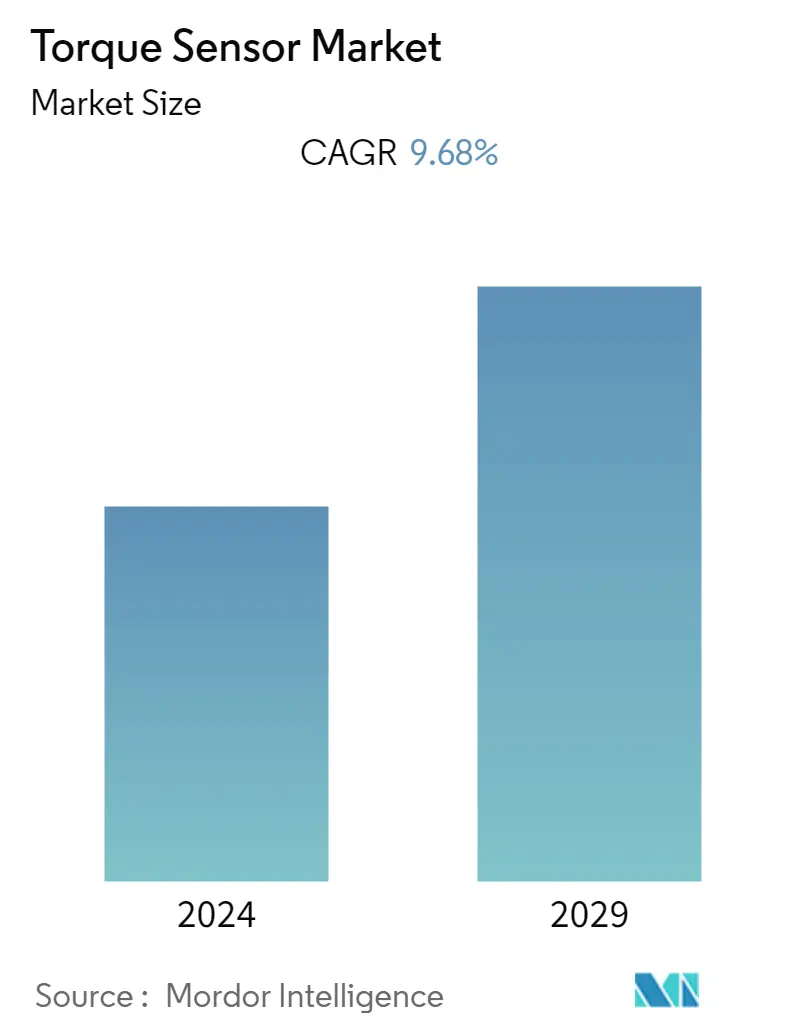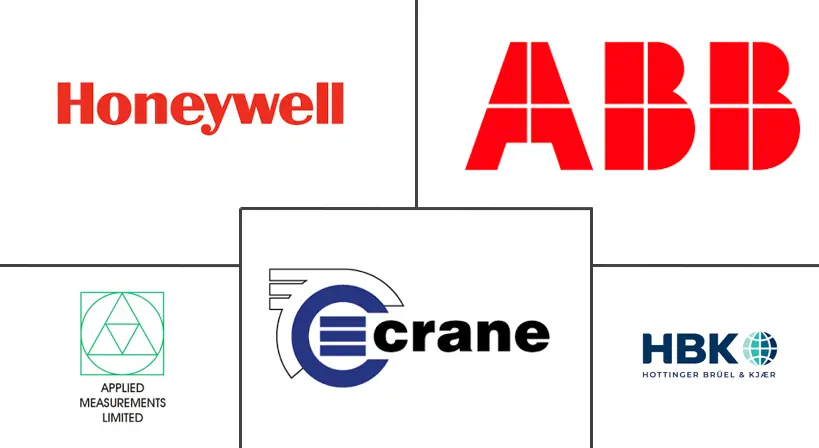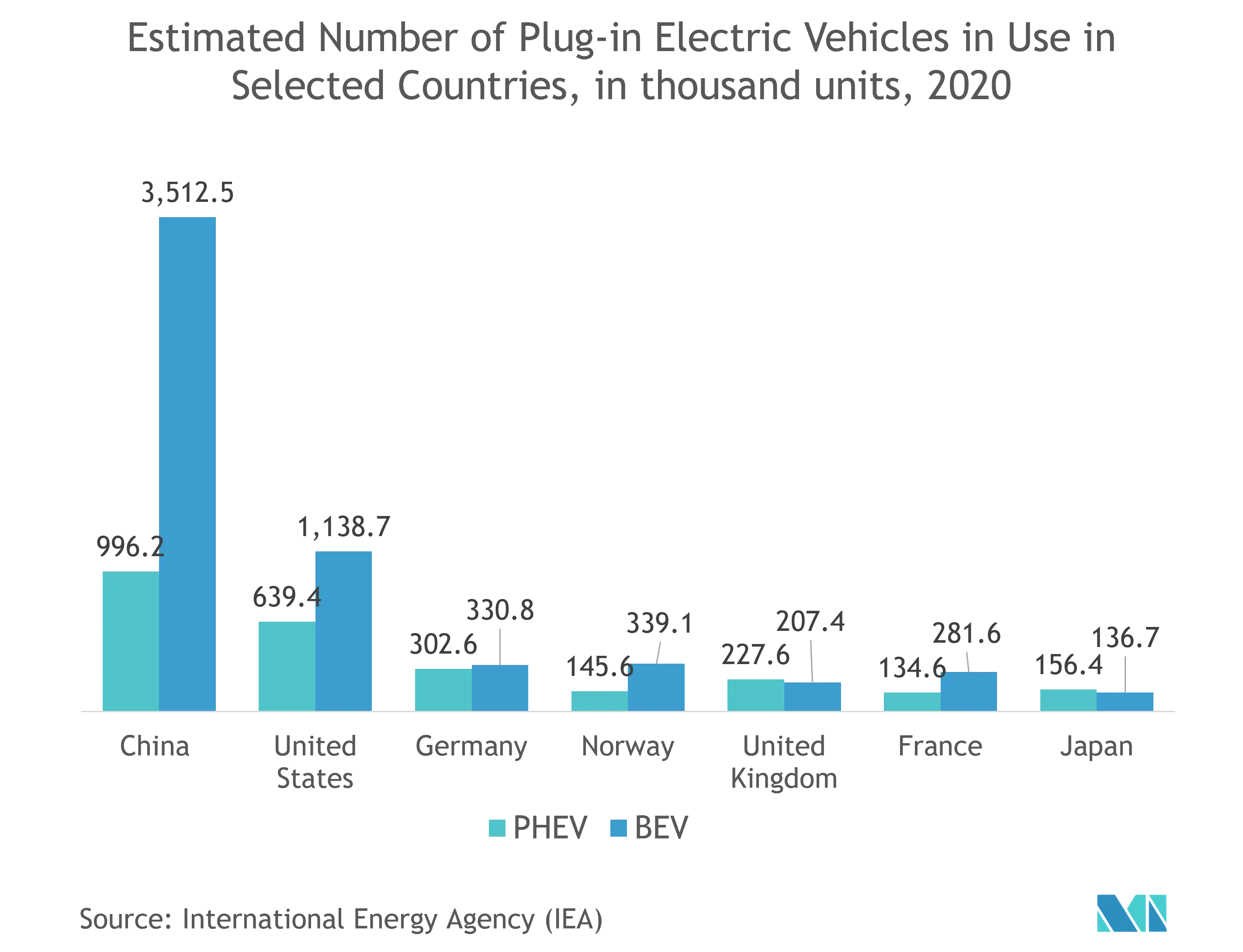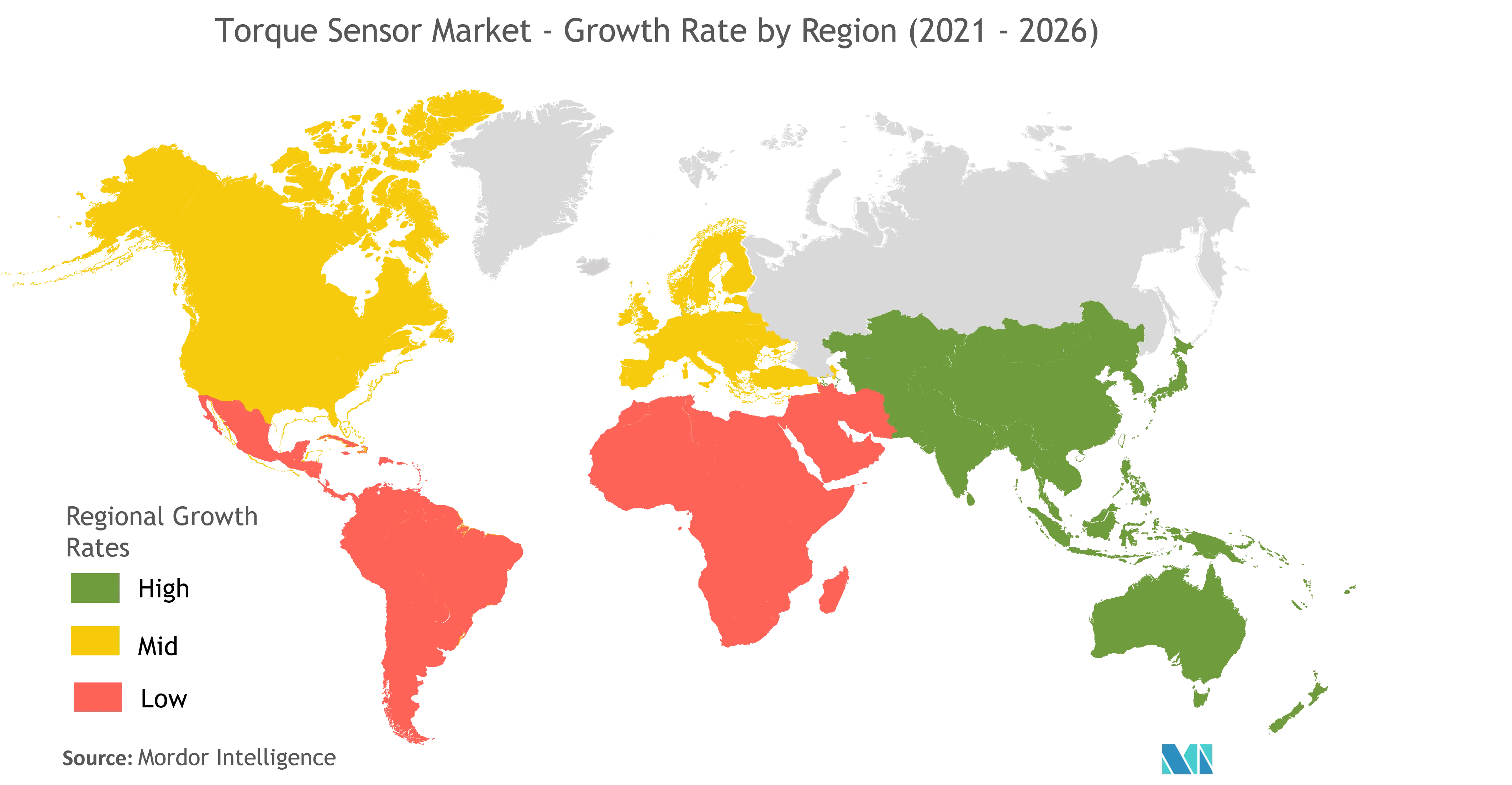Torque Sensor Market Size

| Study Period | 2019 - 2029 |
| Base Year For Estimation | 2023 |
| CAGR | 9.68 % |
| Fastest Growing Market | Asia-Pacific |
| Largest Market | Asia-Pacific |
| Market Concentration | Low |
Major Players
*Disclaimer: Major Players sorted in no particular order |
Torque Sensor Market Analysis
The torque sensor market was valued at USD 6.73 billion in 2020, and it is expected to reach USD 11.63 billion by 2026, registering a CAGR of 9.68% during the period 2021-2026. Due to the COVID-19 pandemic, the global supply chain and demand for multiple products have majorly been disrupted. The need for multiple products in various end-user industries has experienced disruption, which negatively impacted torque sensor demand and future adoption in various applications. Moreover, due to production shutdowns in countries such as China, multiple industries observed a shortage of various products during February and March 2020. Due to supply chain disruptions, the raw material prices increased, impacting the overall pricing of the sensor and related systems.
- Torque sensors measure torque through various methods. The basic principle is a mechanical process, which measures the "force" being used (or attempting) to turn an element. Also, when a force of "torque" is applied to a shaft, the shaft twists (by a minimal amount).
- Further, improvements in technology and integration of wireless and digital components into torque sensors are expected to help sustain the market's growth. Moreover, Industry 4.0, industrial automation, robotics, and smart factory concepts are increasing the market opportunities for torque sensors. The upward trend in the aerospace, automotive, and medical sectors is driving demand in the market.
- Moreover, with demand increasing for improving safety, control, and pilot operations, various aerospace companies are expected to adopt torque sensors because these sensors measure in-flight torque controls, actuation systems, and braking systems. Also, to remain competitive in the market, torque sensor vendors are coming up with new products suitable for specific applications.
- Market vendors are integrating new technologies to launch new products in the market. Most torque sensors need slip rings to transfer torque readings from the rotating shaft to the static readout. Generally, this system is noisy to use, slow to set up, and wearing parts are not always reliable. Some companies have integrated wireless technologies with surface acoustic wave (SAW) detection to overcome these challenges.
- For instance, in December 2020, UK sensor manufacturer, Sensor Technology, announced a new generation of non-contact torque sensors based on four-element strain gauge bridges that complement its existing non-contact sensors, which use surface acoustic waves (SAW) detection, but offer improved accuracy for the same price.
- One of the significant challenges the market faces is the challenge posed by the technology due to the diversity of applications of torque sensors. Due to diverse applications in different environments, the accuracy and reliability of these sensors get compromised. Moreover, electric vehicle drives run at significantly higher rotational speeds, creating challenges for torque sensors.
- Furthermore, surgeons demand devices in the medical industry to allow precise control and repeatable movement, usually in a compact footprint. Torque sensors coupled with advanced electronics can help provide such capabilities. These sensor developers encounter engineering challenges integrating them into the devices, particularly for surgical robotics. For instance, measuring the torque moment is critical to ensure that robotic tools can perform precise and seamless movements, but incorporating sensors into these complex medical systems creates challenges for the developers.
Torque Sensor Market Trends
This section covers the major market trends shaping the Torque Sensor Market according to our research experts:
Automotive Applications Accounts For the Largest Market Share
- Torque sensors have been used in the automotive industry for quite a long time as rotary torque sensors are used for testing gearbox, strain measurement, testing clutch, brake, suspension system, powertrain, and dynamic torque within the engine.
- With the increasing production of the automobile, the market caters a potential growth. Amid the Covid-19 pandemic, the global light vehicle production dropped to around 70 million units in 2020. The automotive market is anticipated to bounce off, reaching the pre-pandemic production volumes around the year 2023. In 2025, it is projected that some 93 million light vehicles might be produced worldwide (source: Schaeffler Gruppe).
- Further, electric vehicles do not require a gearbox or clutch. Still, the engines generate torque used to power a narrow band of engine speed or gears, and also the same torque is also used for acceleration. Thus, drives the need for torques sensors in the market.
- Torque is also involved in the steering wheel rotation, and various developments to enhance the steering wheel are driving multiple opportunities for the company. For instance, in September 2020, Schaeffler partners with Bosch Automotive Steering to introduce and expand the Intelligent mechatronic Rear Wheel Steering system portfolio. The technology will involve collecting data based on the steering wheel torque sensor. The control units are already integrated with the electronic controller calculates to assist in steering for the rider. Also, the torque applied by the driver is calculated as it accounts for several other vehicle parameters. Therefore, such parameters are driving the market growth.
- Moreover, with the increasing demand for automobiles, the manufacturing sectors in the automotive industry is leveraging automation process with advanced robotics. For example, large robots with high payload capabilities and long reach are being used to weld car body panels, while smaller robots are being used to weld subassemblies such as brackets and mounts. Robotic MIG and TIG arc welding positions the torch in the same orientation every cycle. With its repeatable speed and arc gap, ensure every fabrication is welded with the same high standard. Such applications are driving the need for torque sensors in the automotive sector.
- Further, the automotive sector is witnessing huge demand for autonomous vehicles in North America and Europe and driving torque sensors. For instance, Tesla uses a torque sensor for the steering wheel to determine if drivers are paying attention to the steering. Many drivers in the region have been publicly documented for hacking the systems to stay hands-free. Such developments enable the automotive vendors to ensure safety on the roads.

Asia Pacific is Expected to Account For Significant Market Share
- Countries such as Japan, South Korea, China, and India are rapidly transforming their manufacturing sector with automated equipment to increase production efficiency and meet the industry needs. Moreover, the industrial automation and robotic industry are witnessing the growing adoption of rotary torque sensors, which is, in turn, driving the market.
- Its automotive sector majorly dominates the demand for torque sensors in India. According to Catapult Organizations report 2021, electric vehicles (EVs) currently account for less than 1% of total vehicle sales in India; the market is increasing and is expected to be worth around at least GBP 4.8 billion (INR 475 billion) by 2025. However, two-wheelers account for the largest share of this market at 62%, followed by three-wheelers at 37%. Further, the favoring government policies and heavy investments from automakers are expected to spike the demand for torque sensors for the automotive industry in India.
- On the other hand, according to Hennessy Funds, Japan is the global leader in producing robots and factory automation systems and holds 30% of the worldwide market share. Further, the global demand for industrial robots is growing at 46% annually, and the global robotics market is estimated to reach USD 248.5 billion by 2025. Such figures depict the rising demand for torque solutions in the industrial automation sector, with Japan being the primary aggregator in the market.
- In 2020, China’s industrial robotics market grew by 9.5%, further indicating increased demand for torque sensors. Moreover, the Chinese government aims to double domestic companies’ market share from 30-40% to 70% by 2025, according to the country’s five-year plan approved earlier in the year 2021.
- Moreover, Leading Chinese industrial robot maker Youibot generated USD 15.5 million in its latest funding round led by SoftBank Ventures in May. The Shenzhen-based startup also had a full year in 2020, completing multiple financing rounds and winning several awards for its ingenuity.
- Further, several companies are taking strategic measures to tap into the rising demand for torque solutions in the market. For instance, In July 2020, NSK Ltd. has developed a non-contact torque sensor capable of measuring the torque of drive shafts in vehicles in real-time. This is the first sensor in the world of this type and capability. This new technology can increase fuel economy (reduce power consumption), improve ride comfort and safety, and open up a world of new possibilities across CASE.

Torque Sensor Industry Overview
The torque sensors market is fragmented and highly competitive due to several vendors, including ABB Ltd., Crane Electronics Ltd, Applied Measurements Ltd, Crane Electronics Ltd, and Honeywell International. Most of the companies concentrate their efforts on the development of torque sensors for multiple applications.
- April 2021 - Datum Electronics Ltd has partnered with Nautils Labs to provide shipowners, operators, technical managers, and charterers with a comprehensive vessel digitalization and predictive decision support solution.
- January 2020 - TE Connectivity (TE) designed a safety torque sensor with integrated and improved functional safety, including increased accuracy and speed, in advance human-robot collaboration to address the growing demand for safe and collaborative robots in manufacturing.
Torque Sensor Market Leaders
-
ABB Ltd
-
Crane Electronics Ltd
-
HBK Benelux (Spectris PLC)
-
Applied Measurements Ltd
-
Honeywell International
*Disclaimer: Major Players sorted in no particular order

Torque Sensor Market News
- April 2020 - Infineon Technologies AG announced the completion of the acquisition of Cypress Semiconductor Corporation. The company also stated that the addition of Cypress would let Infineon further strengthen its focus on structural growth drivers and a broader range of applications. This will also accelerate the company's path for profitable growth. Cypress primarily adds a differentiated portfolio of microcontrollers, connectivity components, software ecosystems, and high-performance memories, all of which complement the company's power semiconductors, automotive microcontrollers, sensors, and security solutions.
- January 2020 - ABB announced plans to launch its smart sensor for rotating machines operating in hazardous areas at Hannover Messe 2020. This new generation of smart sensors may provide high-quality data to enable ABB's advanced analytics to be used in dangerous locations. This product launch may extend the existing scope of applications for ABB smart sensors with a new generation design for hazardous areas.
Torque Sensor Market Report - Table of Contents
1. INTRODUCTION
- 1.1 Study Assumptions and Market Definition
- 1.2 Scope of the Study
2. RESEARCH METHODOLOGY
3. EXECUTIVE SUMMARY
4. MARKET INSIGHTS
- 4.1 Market Overview
-
4.2 Industry Attractiveness - Porter's Five Forces Analysis
- 4.2.1 Bargaining Power of Suppliers
- 4.2.2 Bargaining Power of Buyers
- 4.2.3 Threat of New Entrants
- 4.2.4 Threat of Substitutes
- 4.2.5 Intensity of Competitive Rivalry
- 4.3 Assessment of the COVID-19 Impact on the Market
- 4.4 Industry Value Chain Analysis
-
4.5 Technology Snapshot
- 4.5.1 Magnetoelastic
- 4.5.2 Strain Gauge
5. MARKET DYNAMICS
-
5.1 Market Drivers
- 5.1.1 Increase in Use of Torque Sensors in Robotics
- 5.1.2 Demand for Torque Sensors For Electric Power Steering (EPS) Systems
-
5.2 Market Challenges
- 5.2.1 Less Reliability of Torque Sensors in Certain Applications
6. MARKET SEGMENTATION
-
6.1 By Product Type
- 6.1.1 Reaction Torque
- 6.1.2 Rotational Torque
-
6.2 By Application
- 6.2.1 Automotive
- 6.2.2 Aerospace
- 6.2.3 Manufacturing
- 6.2.4 Medical
- 6.2.5 Other Applications
-
6.3 By Geography
- 6.3.1 North America
- 6.3.2 Europe
- 6.3.3 Asia Pacific
- 6.3.4 Rest of the World
7. COMPETITIVE LANDSCAPE
-
7.1 Company Profiles
- 7.1.1 ABB Ltd
- 7.1.2 Crane Electronics Ltd
- 7.1.3 HBK Benelux (Spectris PLC)
- 7.1.4 Applied Measurements Ltd.
- 7.1.5 Honeywell International
- 7.1.6 Norbar Torque Tools Ltd
- 7.1.7 Infineon Technologies AG
- 7.1.8 Teledyne Technologies, Inc.
- 7.1.9 TE Connectivity Ltd
- 7.1.10 Datum Electronics Ltd (Indutrade AB)
- 7.1.11 PCB Piezotronics, Inc.
- 7.1.12 Kistler Instrumente AG
- 7.1.13 MagCanica, Inc.
- *List Not Exhaustive
8. INVESTMENT ANALYSIS
9. FUTURE OF THE MARKET
** Subject To AvailablityTorque Sensor Industry Segmentation
The study tracks revenues generated by vendors manufacturing and providing torque sensors for various applications in industries, such as automotive, aerospace and defense, and manufacturing, among others. Actuators are excluded from the scope of the study, and transducers mentioned in the study are exclusively for sensors. Further, the market estimation tracks the revenue from torque sensors offered to different end-user applications' customers. The revenues tracked for the study exclusively include hardware. Moreover, torque sensors used in surgical robots are considered under the medical application segment. In contrast, other robots, such as collaborative robots that use torque sensors, are considered under the other applications segment. The report covers and analyses the impact of the COVID-19 pandemic on the market, its stakeholders, and the same has been considered while arriving at the current market estimation and for future projections.
| By Product Type | Reaction Torque |
| Rotational Torque | |
| By Application | Automotive |
| Aerospace | |
| Manufacturing | |
| Medical | |
| Other Applications | |
| By Geography | North America |
| Europe | |
| Asia Pacific | |
| Rest of the World |
Torque Sensor Market Research FAQs
What is the current Torque Sensor Market size?
The Torque Sensor Market is projected to register a CAGR of 9.68% during the forecast period (2024-2029)
Who are the key players in Torque Sensor Market?
ABB Ltd, Crane Electronics Ltd, HBK Benelux (Spectris PLC), Applied Measurements Ltd and Honeywell International are the major companies operating in the Torque Sensor Market.
Which is the fastest growing region in Torque Sensor Market?
Asia-Pacific is estimated to grow at the highest CAGR over the forecast period (2024-2029).
Which region has the biggest share in Torque Sensor Market?
In 2024, the Asia-Pacific accounts for the largest market share in Torque Sensor Market.
What years does this Torque Sensor Market cover?
The report covers the Torque Sensor Market historical market size for years: 2019, 2020, 2021, 2022 and 2023. The report also forecasts the Torque Sensor Market size for years: 2024, 2025, 2026, 2027, 2028 and 2029.
Torque Sensor Industry Report
Statistics for the 2024 Torque Sensor market share, size and revenue growth rate, created by Mordor Intelligence™ Industry Reports. Torque Sensor analysis includes a market forecast outlook to 2029 and historical overview. Get a sample of this industry analysis as a free report PDF download.



